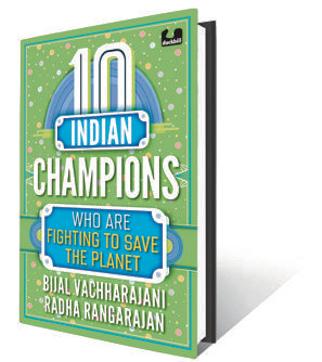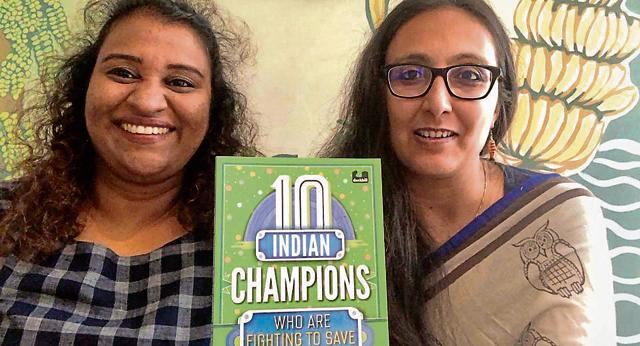Review: 10 Indian Champions Who Are Fighting To Save the Planet by Bijal Vachharajani and Radha Rangarajan
A glowing tribute to the work of individual environmentalists and traditional communities that engage in conservation practices

Doom scrolling is the newest word in my lexicon. It is useful shorthand to describe the countless hours of screen time we devote to consuming every painful little detail about the tragedies unfolding on our planet. With the COVID-19 pandemic and frequent natural disasters trending on television and social media, there has been no respite from being told that the world is a wretched place.
My appetite for wallowing in self-pity is limited so I tend to look for ways to uplift my mood and get on with life. Since I am going to die one day like everyone else, I might as well make the most of it while I am alive. Stories of people who are doing something constructive have an immediate appeal for me as opposed to those who whine endlessly but get nothing done.
Bijal Vachharajani and Radha Rangarajan’s book 10 Indian Champions Who Are Fighting To Save the Planet is woven around people who walk their talk rather than dish out doomsday scenarios or false hope. It is a slim volume packed with nuggets of information about “researchers, writers, activists, conservationists, scientists, cartoonists, all fighting the good fight against the climate crisis, the burgeoning waste problem, food insecurity and polluted waters... standing up for underwater and terra firma denizens, for birds, snakes, mammals and corals.” The book can be enjoyed by older children, teenagers and adults.
Vachharajani has a Masters in Environment Security and Peace from the University of Peace in Costa Rica. She has rescued parakeets, tigers and elephants, apart from creating a number of books for children. She writes on sustainability, food and climate change. Rangarajan edits a nature magazine, and has written several picture books for children. She also dabbles in photography, filmmaking and art. Their love for the earth and its creatures is evident in every page of the book.
The authors write, “What we want this book to establish is that the environment is not the other — it’s a dynamic part of each of us, and we are a part of the environment. And we hope that this book shows that there are different ways to champion wildlife and nature — it can be the simple act of writing a letter to actively working in the field, to volunteering for a tiger census or examining the life cycle of a butterfly in your garden, to drawing stories about our planet, to filing a Public Interest Litigation about an environmental issue that directly impacts you.”
What makes this book refreshing is the fact that it expands our idea of what it means to be an environmentalist. It has several recommendations about small steps that readers can take in order to live responsibly and respect other species. The champions profiled by the authors come from a variety of backgrounds, so there is never a dull moment even if the technical vocabulary seems daunting. Their stories are told in a warm, conversational style, which presents them as ordinary people who have made thoughtful choices rather than superheroes with capes and special abilities.
Like Whitaker, known as the ‘Snake Man of India’, who has been researching and protecting snakes and crocodiles, and busting myths and stereotypes about reptiles through his writing, talks and films. He also helped set up protected areas such as national parks and biosphere reserves away from human habitation to control the exploitation of natural resources. Then there is Laxmi Kamble who works with the hip-hop and percussion band Dharavi Rocks to create awareness about waste management and recycling. The band uses broken buckets, washing machine parts, bottles and cans to fashion musical instruments. This reduces the amount of trash going into landfills, and encourages those who work as ragpickers to explore new career options.

Some of the other champions featured in the book are: Jay Mazoomdar, whose wildlife reporting has shed light on the poaching trade and unearthed the disappearance of tigers; Kavitha Kuruganti, who works on food security issues and getting recognition for women farmers; Rohan Arthur, who studies the impact of climate change on coral reefs; Aparajita Datta, who has worked on long-term monitoring of the hornbill population in Arunachal Pradesh; Vidya Athreya, who studies leopard ecology when they live among human beings in agricultural settings; Minal Pathak, who makes scientific information accessible to governments across the world to formulate climate policies; and Parineeta Dandekar, whose writing and research serves as a bridge between policymakers, ecologists, scientists and people meant to protect India’s water bodies.
The outlier among them is Rohan Chakravarty, a cartoonist who uses humour to make people engage with the grave subject of climate change instead of feeling overwhelmed. He says, “There was a point in my life where I really wanted to become a wildlife scientist... But I soon realized that I did not have the patience to wait for an owl to poop so I could dissect its pellets. I think that my aversion to academics (and a staple diet of Yash Chopra films) has helped keep the romance in me alive, something that’s very necessary for being an artist of any kind.” He has also illustrated wildlife maps of India, Bhutan, China and Hong Kong.
While this book pays glowing tributes to the work of adult champions, and traditional communities that engage in conservation practices, it loses out on celebrating the contributions of child activists such as Licypriya Kangujam from Manipur and Ridhima Pandey from Uttarakhand. They belong to a generation that will face the impact of climate change in the harshest of ways, so they ought to be part of a conversation that shapes their future. Perhaps we need to look beyond Greta Thunberg, and nurture the young environmentalists in our own country.
Chintan Girish Modi is a writer, educator and researcher. He is @chintan_connect on Twitter.





